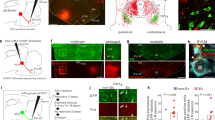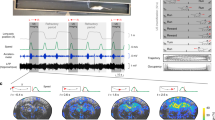Abstract
The decerebrate rat locomotor preparation described in a previous study requires extensive brain surgery with the possibility of significant blood loss. The purpose of this study was to improve on the previous model by using lightly anesthetized instead of decerebrated rats. After initial surgery consisting of boring a small hole through the parietal bone, the animals were maintained on low levels of halothane anesthetic. The mesencephalic locomotor region was then located by physiological criteria using stereotaxic coordinates from the previous study. Locomotor speed, blood pressure and heart rate responses were then measured over a wide range of stimulation currents that elicited a maximal running speed. Stimulation currents ranged from 36 μA for walking to 82 μA for fast galloping. Locomotor speeds ranged from 20 m/min for walking to 64 m/min for fast galloping. Some animals easily achieved galloping speeds beyond 100 m/min. Blood pressure and heart rate increased with increasing stimulation currents. Blood pressure also increased during stimulation after muscular paralysis. This was not due to current spread, suggesting that the mesencephalic locomotor region might be involved in central command mechanisms. Heart rate did not increase after paralysis. This supports other multi-joint dynamic studies suggesting that movement per se may be necessary to induce heart rate changes, presumably via joint mechanoreceptors. The range of locomotor patterns and cardiovascular responses were obtained under self-supported conditions. By defining the mesencephalic locomotor region via physiological criteria, and by grouping blood pressure and heart rate measurements by gait rather than by stimulation currents, the potential use of the intact model for cardiovascular control studies was demonstrated. The animals were able to run and gallop at high speeds considering they were anesthetized. The simplified preparation will be useful for more complex cardiovascular experiments requiring intact and self-supported conditions.
Similar content being viewed by others
Author information
Authors and Affiliations
Additional information
Received: 25 November 1996 / Received after revision: 28 February 1997 / Accepted: 6 March 1997
Rights and permissions
About this article
Cite this article
Chong, R., Bedford, T. Heart rate, blood pressure, and running speed responses to mesencephalic locomotor region stimulation in anesthetized rats. Pflügers Arch 434, 280–284 (1997). https://doi.org/10.1007/s004240050397
Issue Date:
DOI: https://doi.org/10.1007/s004240050397




